1. (a) State the law of reflection.
(b) (i) With the aid of the diagram, describe how a pin hole camera works.
(ii) State the nature of the image formed by a pin hole camera.
c) With the aid of the diagram, describe how total eclipse and partial eclipse of the moon occur
d) Explain how a curved mirror can be used as a solar concentrator.
2. (a) (i) what is meant by sound?
(ii) State two factors that affect the motion of sound waves.
d) Figure 4 represents a wave motion in which a crest moves from O to pin 8 seconds.
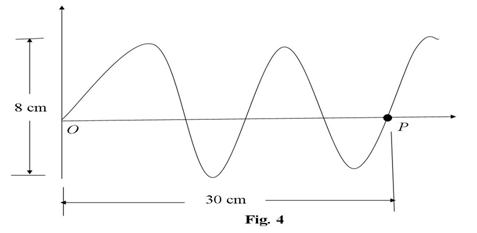
Find
(i). amplitude
(ii) Wave length
(iii) Frequency
(c) Plane waves move towards a reflector as shown in figure 5.
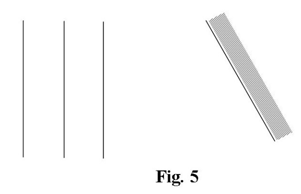
Copy and complete the diagram to show the motion of the waves after reflection.
d) State the effect of constructive interference of
i) Sound waves
ii) Light waves
e) Describe an experiment to demonstrate resonance in a closed pipe
3. (a) Define velocity ratio efficiency as applied to machines
(b) (i) Draw a diagram of a single string pulley system with velocity ratio 6
(ii) Calculate the efficiency of the pulley system in (b) (i) above if an effort of 1,000 N is required to raise a load of 4,500 N.
(ii) Find the wasted when a load of 1,00 N is lifted through 2 m by a pulley system in (b) (i)
(c) Explain why the fulcrum must be nearer to the load than the effort in a first class lever.
(d) Figure1 shows gearwheel.
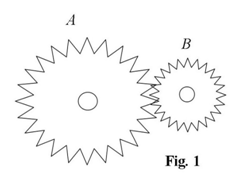
Explain how A and B should engage to give a turning effect force of low mechanical advantage
4. (a) State the law of conservation of energy
(b) Pendulum bob of mass 200 g is pulled sideways through a vertical height of 40 cm.
Calculate the maximum
(i) Potential energy gained.
(ii) Speed of the bob when the pendulum is released.
(c) State why a winging pendulum eventually comes to rest after sometimes.
(d) Explain why a steel ball failing through oil in a falling through oil in tall jar first accelerates and then after acceleration decreases to zero.
(e) (i) Define the terms distance and displacement.
(ii) Sketch a velocity time graph for a body experiencing a net force of zero.
(e) A uniform meter rule is balanced horizontally on a pivot at the 15 cm mark when a load of 7 N is attached at the zero mark as shown in figure 2

Find the weight of the meter rule.
5. (a) What is a saturated vapour
(b) Explain why water boiling in a container stops boiling momentarily when the lid of the container is removed.
(c) A metal block of 3 kg at 1000C is placed in 2.5 kg of water at 310C in a copper calorimeter of 0.4 kg. The water is then stirred until it attains a steady temperature of 430C. Calculate the specific heat capacity of the metal block
d) (i) List the possible sources of errors in an experiment like the one in (c) above.
(ii) Suggest how each of the errors you have listed in (d) (i) can be minimized.
e) The set up in figure 3 is used to demonstrate convection in air.
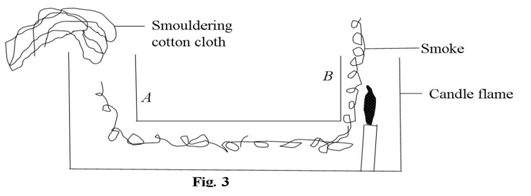
Explain why smoke from the smoulding cotton cloth is seen to enter through cylinder A and come out through B.
6. (a) (i) what is a magnetic field?
(ii) Sketch the magnetic the magnetic field pattern between two bar magnet placed on horizontal surface with their south poles facing each other
(b) (i) Explain why the strength of a magnet cannot be increased beyond a certain limit
(ii) With the aid of a suitable diagram, show how a U-shape piece of steel can be magnetized by electrical method.
(c). A bare copper wire AB lies horizontally over fixed rails X and Y connected to a battery as shown in figure 6
The rails X and Y are placed between the poles of a U-shaped magnet.
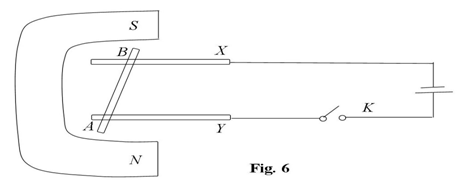
Explain what happened to AB
(i) when switch K is closed
(ii) If two cells are used instead of one cell.
(d) Name two instruments which use the effect in (c)
(e) State two ways of demagnetizing a magnet.
7. (a) (i) Define electrical resistance.
(ii) State three physical properties that affect resistance of a mental wire.
(b) Draw sketch graph of current against p.d for the following.
(i) A metal wire
(ii) A semi –conductor diode
(c) A battery of e.m.f 30 V and negligible internal resistance is connected across three resistors of 5 Ω, 2 Ω and 2 Ω as shown in figure 7.
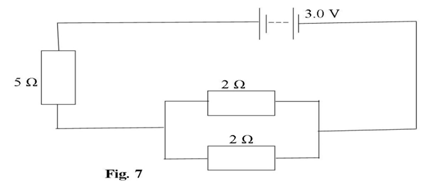
Calculate the;
(i) Current supplied by the battery
(ii) Power dissipated in the 5 Ω resistor.
(d) Explain why a wire heats up when current is passed through it.
8. (a) what are cathode rays?
(b) (i) Draw a labeled diagram to show the main features of a cathode ray tube.
(ii) Describe briefly how cathode rays are produced in the cathode ray tube.
(iii) State two uses of a cathode –ray oscilloscope.
(c) Define he following terms as applied to radioactivity.
(i) Isotope.
(ii) Half – life.
(d) The diagram in figure 8 shows the path of a particle P, emitted from a radioactive of rock. Passing through a religion of uniform magnetic field directed perpendicular into paper.
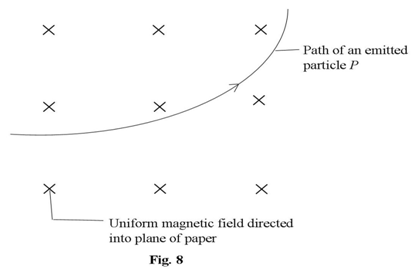
Identify the particle P.
Describe the changes that place in the nuclear structure of an element X with atomic number 88 and mass number 226 when it emits particle P, identified in d) (i)
(e) (i) The mass of a radioactive substance decays to 1/6 of its original value after36 days. Find its half life.
State one medical use and one non-medical use of radioactive tracers.
